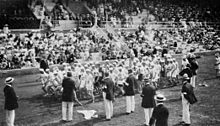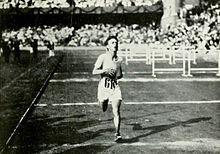1912 Summer Olympics / Athletics - Marathon (Men)
|
|
|||||||||

|
|||||||||
| sport | athletics | ||||||||
| discipline | Marathon run | ||||||||
| gender | Men | ||||||||
| Attendees | 68 athletes from 19 countries | ||||||||
| Competition location |
Stockholm Olympic Stadium (start and finish) |
||||||||
| Competition phase | July 14, 1912 | ||||||||
|
|||||||||
The men's marathon at the 1912 Olympic Games in Stockholm was held on July 14, 1912. 68 athletes took part, of which only 35 made it to the finish. The route led right through the Swedish capital, start and finish were the Stockholm Olympic Stadium . At 40.2 km, the route was almost 2 km shorter than the standard of 42.195 km.
The Olympic champion was the South African Ken McArthur , who reached the finish just a minute before his compatriot Christopher Gitsham . The bronze medal went to the American Gaston Strobino .
Existing records
- World best: 2:40:35 h - Thure Johansson ( Sweden ), Stockholm , August 31, 1909. World records are not set in marathons because of the different track conditions.
- Olympic record : 2:55: 18.4 h - John Hayes ( USA ), Olympic Games in London , July 24, 1908
The race
Date: July 14, 1912
The race in the Olympic Stadium started at a temperature of approx. 32 ° C. The runners initially ran north towards Sollentuna . This is where the turning point, which was first used in an Olympic marathon route, was located - see photo in the info box . The Finn Tatu Kolehmainen, brother of the Olympic champion over 10,000 meters, and the two South Africans Christopher Gitsham and Kenneth McArthur formed the leading group. Behind them was a chase group with the Swedes Alexis Ahlgren, Sigfrid Jacobsson, the British Frederick Lord, the Italian Carlo Speroni and the Canadian James Corkery.
While Kolehmainen and Gitsham were able to pull away a little, a momentous drama broke out at kilometer 29. The Portuguese Francisco Lázaro , who rubbed himself with wax to protect himself from the sun, collapsed and collapsed because his body could no longer sweat and the electrolyte balance was completely disrupted. Lázaro was taken to hospital but died the next morning. This makes him the first athlete to die as a result of his competitions during the modern Olympic Games.
The Japanese Kanaguri Shisō was completely exhausted at 30 km. He saw residents of a house drinking juice and asked for a glass. The residents asked him into the house, the athlete wanted to rest briefly on a couch and fell asleep. He only woke up the next morning. Kanaguri was ashamed and did not want to return to his homeland at first, but then he did. In 1967 he returned to Stockholm and resumed the run exactly where it had stopped and finished the race. He reached the goal in the Olympic Stadium after 54 years, 8 months, 6 days, 32 minutes and 20.3 seconds.
Kolehmainen had to give up the race at 35 km. McArthur meanwhile had worked his way up to his compatriot. The chasing group was broken up, only the Swede Jacobsson and the American Strobino were able to stay a minute behind the two top runners. There was a supply point a few kilometers from the stadium. Gitsham stopped to drink while McArthur continued and eventually won by a comfortable margin. Although the distance of 40.2 km did not correspond to the marathon length of 42.195 km, the victory time was recognized as a new Olympic record.
All runners who could not win a medal and who did not need more than 120% of the victory time (approx. 3:17 hours) were awarded a certificate of honor.
Result
Picture gallery
literature
- Ekkehard zur Megede , The History of Olympic Athletics, Volume 1: 1896-1936, Verlag Bartels & Wernitz KG, Berlin, 2nd edition 1970, pp 110-112
Video
[accessed August 26, 2017 Olympics 1912 Marathon], published July 29, 2012 on youtube.com, accessed August 26, 2017
Web links
- SportsReference Marathon , accessed August 26, 2017
- Official report , engl. (PDF), accessed on August 26, 2017
















